No8 DRESS UNIFORM 1970 - 1991
No.8 - DRESS COMBAT TEMPERATE (1968)
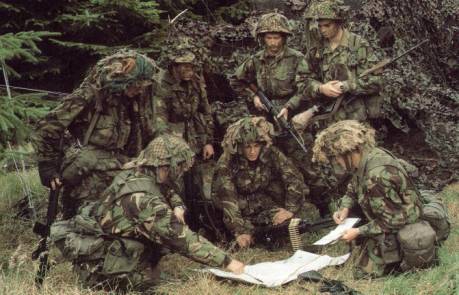
In 1968 the 68 pattern DPM (Disruptive Pattern Material) was introduced as the No.8 dress pattern uniform,
and was in general issue from 1972 until 1986, it was designed around the 1960 Pattern Olive Combat Uniform.
The 1968 Pattern uniform was double lined and extremely hard wearing. The 68 combat trousers had a rear pocket, a cargo
pocket mid thigh on each leg, one slash pocket at the top of each leg, and a Field Dressing pocket to the
right of the zip fly. They were designated "Trousers Combat 8415-99-132-2037"
LABEL TROUSERS COMBAT (1968 early issue)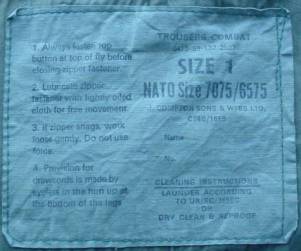 |
LABEL TROUSERS COMBAT (1968 later issue) |
FIELD DRESSING POCKET, TROUSERS COMBAT (1968)
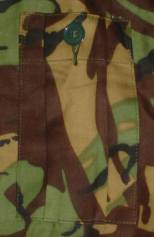
The 68 Combat Smock was also double lined, it had an inside pocket on the left breast, 4 large pockets two at the chest
and two at the waist and small pocket at the top of the left arm. The cuffs were adjustable by two buttons, and a cold
weather hood (8415-99-132-2048), could be attached by three buttons at the neck. The smock also had a parachute style flap at the back, which
buttoned to the front of the smock.
SMOCK COMBAT (1968) ARM POCKET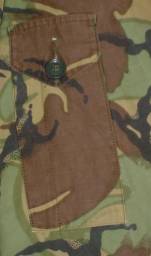 |
SMOCK COMBAT (1968) PARACHUTE FLAP |
SMOCK COMBAT TEMPERATE (1968)

HOOD COLD WEATHER (COMBAT DPM), (1968)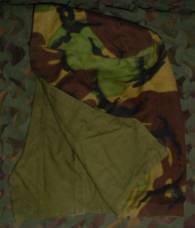 |
LABEL, HOOD COLD WEATHER (COMBAT DPM), (1968)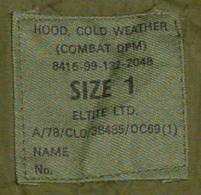 |
Replacing the aged "Denison" Parachute Smock, for issue to Airborne Arms, the 1968 pattern "Smock Parachutists"
NSN 8415-99-132-4915 was developed. It had a heavy duty front zip without a storm flap, the pockets had press stud
fastenings, replacing the buttons. A button fastened pen pocket on the upper left arm, buttoned epaulettes on the shoulders,
wollen cuffs on the sleeves and an external, press stud fastened parachute flap at the rear.
SMOCK PARACHUTISTS (1968)
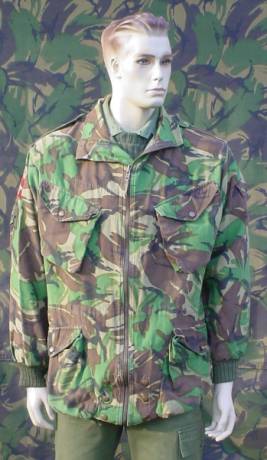
In 1984 an updated "Smock Parachutists", (8415-99-132-4017), was issued. It had the same design as the 1968 pattern with the addition of a First Field Dressing pocket was placed at the rear of the upper right arm,
A DPM cap was also available as part of the 1968 pattern issue, designated "Hat, Combat Temperate" 8415-99-132-1849.
It was often referred to as the "Crap Hat" or "Crows Hat".
HAT, COMBAT TEMPERATE (1968)

By the middle of the eighties a new combat uniform was developed and issued from 1986.
This became known as the "1984 Pattern". It had the same basic design but unlined, and lighter more modern materials
were used, rendering the uniform less hard wearing. The 1984 pattern trousers were of the same basic design as the "68 trousers"
but the rear pocket and field dressing pocket were removed, although the cargo pockets were much larger. The 84 pattern Smock
was also less hard wearing, due to the materials used, although the smock design was similar to the 68 pattern.
SMOCK COMBAT TEMPERATE (1984) |
TROUSERS COMBAT TEMPERATE (1984) & SHIRT GS |
It was not uncommon in the late eighties, to see both types of uniform being used as many of the more experienced soldiers
preferred the durability of the "68 combats", and the "Shirt, Combat Tropical" was often used in place of the "Shirt GS".
ROYAL ENGINEER IN No8 DRESS: SHIRT COMBAT TROPICAL,
STABLE BELT, TROUSERS COMBAT (1984 Pattern) & BOOTS COMBAT HIGH
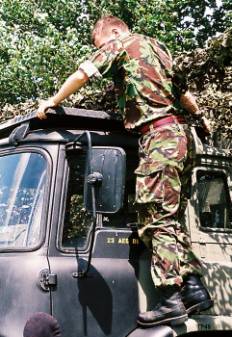
With the introduction of the "84 pattern" uniform, the wollen KF shirt was discontinued and replaced by an
Olive Green, denim type shirt designated "Shirt GS", and Puttees were discontinued due to the introduction of
the new high leg boots designated "Boots Combat High".
MK6 HELMET, 1968 PATTERN No8 DRESS, BOOTS DMS & PUTTEES,
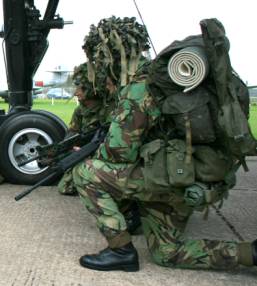
Extreme Cold Weather clothing (ECW) was developed to augment the 1968 pattern No8 Dress for those serving in Northern Europe.
A DPM Parka NSN 2408-98-121-8887, using the same materials and a similar design, as the 1968 pattern Smock Combat. It was
much longer, almost knee length, and was used during the Falklands Campaign, and became known as the "Falklands Parka"
instead of it's correct designation "Parka Man's (Cold Weather) 1968". Features include: wired hood with integral quilted
lining, drawstring neck and waist, attachments for rank slides on ether shoulder, four bellows pockets in front,
parachute flap to stop the parka riding up during strenuous activates, heavy duty double zip and removable liner
(NSN 8415-99-137-5029).
In 1984 the design of the Parka was changed, velcro adjusters at the cuffs and larger buttons. This was
designated "Parka Man's (Cold weather) 1984 (NSN 8405-99-132-2532).
PARKA MAN'S (COLD WEATHER) 1984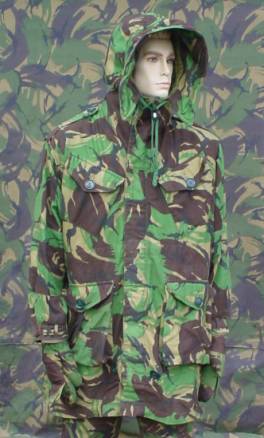 |
PARKA MAN'S (COLD WEATHER) 1984 & HAT COMBAT (COLD WEATHER) 1968 |
In conjunction with the Parka, two seperate quilted liners were issued, with or without sleeves.
LINER, COLD WEATHER JACKET

LABEL LINER, COLD WEATHER JACKET, EARLY & LATER ISSUES
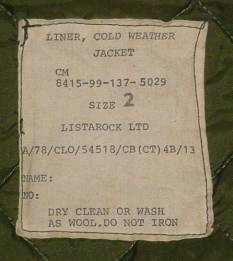 |
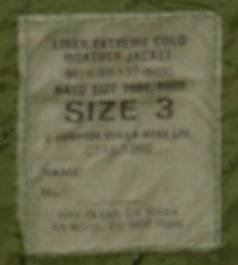 |
LINER, COLD WEATHER JACKET (without sleeves) & LINER, COLD WEATHER TROUSERS
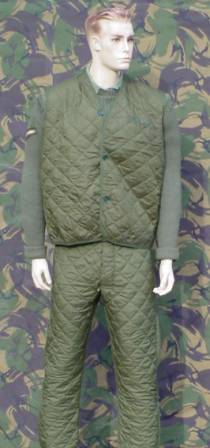
Quilted trousers were also issued as a supplemental lining for the "1968 Pattern, Trousers Combat".
Also to supplement the ECW clothing an ECW DPM Hat was issued. The 1968 pattern issue hat was quilt lined and had faux fur
ear flaps that could be worn up or down, depending on temperature requirements. The later 1984 pattern issue hat was faux fur
lined. In addition downfilled ECW DPM Mitts (Mittens Arctic Mk1) were issued as an inner, with single skin trigger
fingers, and a waterproof single skin outer. In 1984 the Mk2 version was issued (inner:8415-99-132-652) , the only difference
being that the filling in the "inners" was synthetic. In the early 1990's the Mk3 was issued (inner:8415-99-132-6523). The
inner is faux fur lined, the palm was reinforced with anti-slip material. The outer is "Goretex".
HAT COMBAT (COLD WEATHER) 1968 |
HAT COMBAT (COLD WEATHER) 1984 |
WRAC L/CPL IN SNOWSUIT & HAT, COMBAT (COLD WEATHER)

Soldiers often replaced the "Shirt KF", and later the "Shirt GS" with the Norwegian Army Shirt (Norgie) which was 100%
cotton towelling, and much warmer. It was olive green with a zipped polo neck and button cuffs.
NORWEGIAN ARMY SHIRT

SOLDIERS IN ECW 1968 NO.8 DRESS BOARDING WESSEX HELICOPTER"

Gloves, designated "Gloves, Urban Patrol", were issued to troops serving in Northern Ireland and became known as "Northern
Ireland Gloves". They were black leather with a light lining, padded knuckle area and an elasticated cuff at the wrist.
GLOVES, URBAN PATROL
